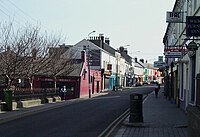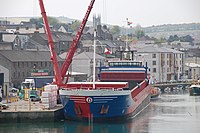Wicklow
| Wicklow Irish: Cill Mhantáin | |
| County Wicklow | |
|---|---|
 Farmland and view of Wicklow Town | |
| Location | |
| Grid reference: | T312940 |
| Location: | 52°58’40"N, 6°1’59"W |
| Data | |
| Population: | 6,761 (2011) |
| Local Government | |
| Website: | www.wicklow.ie |
Wicklow is the county town of County Wicklow. Located south of Dublin on the east coast of Ireland, it has a population of 10,356 according to the 2011 census. It is a port town but also a commuter town for Dublin, which role has come to diominate.
The town stands to the east of the N11 route between Dublin and Wexford. Wicklow is also linked to the rail network, with Dublin commuter services now extending to the town. Additional services connect with Arklow, Wexford and Rosslare Europort, a main ferry port. There is also a commercial port, mainly importing timber and textiles. The River Vartry is the main river which flows through the town.
History
The town of Wicklow was founded by the Norse, who found here a natural harbour and fertile farmland.
There is evidence that the area was occupied from the Bronze Age. During excavations to build the Wicklow road by-pass in 2010, a Bronze Age cooking pit (Fulach Fiadh) and hut site was uncovered in the Ballynerrn Lower area of the town.. A Radio carbon dating exercise on the site puts the timeline of the discovery at 900BC.[1] According to the Greek cartographer and historian, Ptolemy, the area around Wicklow was settled by the Cauci/Canci tribe. The area around Wicklow was referred to as Menapia in Ptolemy's map which itself dates back to 130 AD.[1]
Vikings landed in Ireland around 795 AD and began plundering monasteries and settlements for riches and to capture slaves. Later shipborne Scandinavians came to Ireland to settle and they began to establish settlements along the coast. In the mid-9th century Norse established a base which took advantage of the natural harbour at Wicklow. The Vartry estuary offered safe anchorage and a good over-winter base to repair ships. It is from this chapter of Wicklow's history that the origin of the name 'Wicklow' originates.[1]
The Norman influence can still be seen today in some of the town's place and family names. After the Norman invasion, Wicklow was granted to Maurice FitzGerald who set about building the 'Black Castle', a land-facing fortification that lies ruined on the coast immediately south of the harbour. The castle was briefly held by the local O'Byrne, the O'Toole and Kavanagh clans[2] in the uprising of 1641 but was quickly abandoned when English troops approached the town. Sir Charles Coote, who led the troops is then recorded as engaging in "savage and indiscriminate" slaughter of the townspeople in an act of revenge.[3] Local oral history contends that one of these acts of "wanton cruelty" was the entrapment and deliberate burning to death of an unknown number of people in a building in the town. Though no written account of this particular detail of Coote's attack on Wicklow is available, a small laneway, locally referred to as "Melancholy Lane", is said to have been where this event took place.
Though the surrounding County of Wicklow is rich in Bronze Age monuments, the oldest surviving settlement in the town is the Franciscan Abbey (ruined). This is at the west end of Main Street, within the gardens of the local Roman Catholic parish grounds. Other notable buildings include the Town Hall and the Gaol, built in 1702 and recently renovated as a heritage centre and tourist attraction. The East Breakwater, arguably the most important building in the town, was built in the early 1880s by Wicklow Harbour Commissioners. The architect was William George Strype and the builder was John Jackson of Westminster. The North Groyne was completed by about 1909 - John Pansing was the designer and Louis Nott of Bristol the builder. The Gaol was a place of execution up to the end of the 19th century and it was here that Billy Byrne, a leader of the 1798 rebellion, met his end in 1799. He is commemorated by a statue in the town square. The gaol closed in 1924 and is today a tourist attraction with living displays and exhibits.[4]
At Fitzwilliam Square in the centre of Wicklow town is an obelisk commemorating the career of Captain Robert Halpin, commander of the telegraph cable ship Great Eastern, who was born in Wicklow in 1836.
Geography
Wicklow town forms a rough semicircle around Wicklow harbour. To the immediate north lies 'The Murrough', a popular grassy walking area beside the sea, and the eastern coastal strip. The Murrough is a place of growing commercial use, so much so that a road by-passing the Town directly to the commercial part of the area commenced construction in 2008 and was completed in summer of 2010. The land rises into rolling hills to the west. The dominant feature to the south is the rocky headlands of Bride's Head and 'Wicklow Head', the easternmost mainland point of the Republic of Ireland. On a very clear day it is possible to see the Snowdonia mountain range across the Irish Sea in Caernarfonshire.
Economy
Since 1995, the town has undergone significant change and expansion reflecting the simultaneous growth in the Irish economy, before the crash. Considerable residential development has taken place to the west of the town along Marlton Road (R751). More recently, housing developments have been concentrated to the north-west of the town towards the neighbouring village of Rathnew. The completion of the Ashford/Rathnew bypass in 2004 has meant that Wicklow is now linked to the capital, Dublin, lying 42 km to the north, by dual carriageway and motorway. These factors have led to a steady growth in population of Wicklow and its surrounding townlands while its importance as a commuter town to Dublin increases.
Name
Earlier spellings of the town's name include Wykinglo in 1173, Wygingelow in 1185, Wykinglo in 1192, Wykinglowe in 1355.[5][6]
The Swedish toponymist Magne Oftedal[7] criticizes the usual explanation that the name comes from Old Norse Vikingr (meaning "Viking") and Old Norse ló (meaning "meadow"), that is to say "the Vikings' meadow" or "Viking's meadow". He notices that -lo was never used outside Norway (as it appears in the name, for example of Oslo) and Scandinavia. Moreover, "Viking" never appears in name records. For him, the first element can be explained as Vikar- or Vik- "bay" in Old Norse and the intermediate N of the old forms is a mistake by the clerks.
However, all recorded forms show this N. That is the reason why Liam Price[8] says it is probably a Norwegian place-name and A. Sommerfelt[9] gives it as a former Vikinga-ló and understands it as "the Vikings' meadow".
The origin of the Irish name Cill Mhantáin bears no relation to the name Wicklow. It has an interesting folklore of its own. Saint Patrick and some followers are said to have tried to land on Travailahawk beach, to the south of the harbour. Hostile locals attacked them, causing one of Patrick's party to lose his front teeth. Manntach (toothless one), as he became known, was undeterred and returned to the town, eventually founding a church.[10] Hence Cill Mhantáin, meaning "church of the toothless one". Although its [[anglicisation|anglicised spelling Kilmantan[11] was used for a time, it gradually fell out of use.
Outside links
| ("Wikimedia Commons" has material about Wicklow) |
- Wicklow Tourism page on Wicklow Town
- Wicklow Chamber of Commerce
- History of Wicklow Town in MP3 format
References
- ↑ 1.0 1.1 1.2 John Finlay (2013). Footsteps Through Wicklow's Past.
- ↑ Wills, James Lives of illustrious and distinguished Irishmen. MacGregor, Polson, 1840, p. 449.
- ↑ Wills, James Lives of illustrious and distinguished Irishmen. MacGregor, Polson, 1840, p. 448.
- ↑ S Shepherd et al. (1992). Illustrated guide to Ireland. Reader's Digest.
- ↑ Liam Price, The Place-Names of the Barony of Newcastle, p. 171.
- ↑ Donall Mac Giolla Easpaig, L'influence scandinave sur la toponymie irlandaise in L'héritage maritime des Vikings en Europe en l'ouest, Colloque international de la Hague, Presses universitaire de Caen 2002. p. 467 et 468. Translation Jacques Tranier.
- ↑ Scandinavian Place-Names in Ireland in Proceedings of the Seventh Viking Congress (Dublin 1973), B. Alquist and D. Greene Editions, Dublin, Royal Irish Academy 1976. p. 130.
- ↑ Price p. 172.
- ↑ The English forms of the Names of the Main Provinces of Ireland, in Lochlann. A Review of Celtic Studies. IA. Sommerfelt Editions, Trad. ang. of Oslo University Press 1958. p. 224.
- ↑ The Annals of Clonmacnoise, being annals of Ireland from the earliest period to A.D. 1408. Mageoghagan, Conell & Murphy, Dennis, 1896, p. 66.
- ↑ "Wicklow: Archival records". Placenames Database of Ireland Logainm.ie. http://www.logainm.ie/?text=wicklow&placeID=55959. Retrieved 2013-04-15.
Books
- Cleary, J and O'Brien, A (2001) Wicklow Harbour: A History, Wicklow Harbour Commissioners


